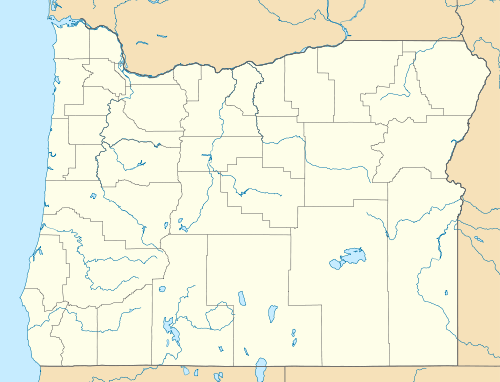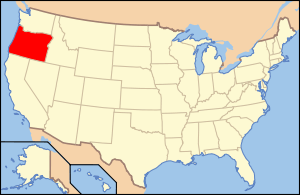Pioneer Courthouse
|
Pioneer Courthouse | |
|
Portland Historic Landmark[1] | |
|
The Pioneer Courthouse as viewed from Pioneer Courthouse Square after 2005 renovations. | |
   | |
| Location |
700 SW 6th Avenue Portland, Oregon |
|---|---|
| Coordinates | 45°31′07″N 122°40′42″W / 45.518624°N 122.678360°WCoordinates: 45°31′07″N 122°40′42″W / 45.518624°N 122.678360°W |
| Built | 1869 |
| Architect | Alfred B. Mullett |
| Architectural style | Italianate |
| NRHP Reference # | 73001582 |
| Significant dates | |
| Added to NRHP | March 20, 1973[2] |
| Designated NHL | May 5, 1977[3] |

The Pioneer Courthouse is a federal courthouse in Portland, Oregon, United States. Built beginning in 1869, the structure is the oldest federal building in the Pacific Northwest, and the second oldest west of the Mississippi River.[4] Along with Pioneer Courthouse Square, it serves as the center of downtown Portland. It is also known as the Pioneer Post Office because a popular downtown Portland post office was, until 2005, located inside. The courthouse is one of four primary locations where the United States Court of Appeals for the Ninth Circuit hears oral arguments. It also houses the chambers of the Portland-based judges on the Ninth Circuit.
History
Built in stages between 1869 and 1903, it was first occupied in 1875 by judge Matthew Deady.[5] At that time the building was named the United States Building.[5] Pioneer Courthouse has survived several attempts to demolish it, while continuing to function as a federal facility. On March 20, 1973, the building was placed on the National Register of Historic Places.[6] It was declared a National Historic Landmark in 1977.[3][7]

In March 1933, city engineer Olaf Laurgaard proposed tearing down the building to open a parking garage.[8] John C. Ainsworth asked Oregon representative Charles Martin and Charles L. McNary to see if President Franklin D. Roosevelt would consider giving the structure and property to the city of Portland.[8] Portland would then renovate the structure for the Oregon Historical Society and The Colonial Dames of America to use.[8] Martin immediately replied that the timing was bad since Oregon was asking for funding of the Bonneville Dam, and it was likely illegal to donate a post office to a city.[8] Ainsworth quickly came up with a new scheme: demolish the Pioneer Courthouse and build an office building for the Historical Society, the Boy Scouts, a theater, and a museum.[8] A. E. Doyle, his architectural firm, the local chapter of the American Institute of Architects, the Colonial Dames, and The Oregon Journal sharply opposed destroying the building.[8]


In 2003, plans for renovating the courthouse sparked an unusual conflict between Portland Democratic congressmen Earl Blumenauer and David Wu. Wu, whose district contains the courthouse, supported a plan that included removing the post office from the courthouse, and adding five parking spaces in its basement. Wu's plan was ultimately adopted, and the $23.4 million renovation of the building was completed in December 2005.[10] The work included the addition of base isolators to protect the historic structure from earthquakes, the secure judges' parking area under the building, and the renovation of the lobby where the post office had been.[4]
Notable trials
The trials of the Oregon land fraud scandal were held in the courthouse, beginning in 1904.[11] These trials were documented at length in Stephen A. Douglas Puter's book Looters of the Public Domain.[11]
See also
References
- ↑ Portland Historic Landmarks Commission (July 2010), Historic Landmarks -- Portland, Oregon (XLS), retrieved November 13, 2013.
- ↑ National Park Service (2007-01-23). "National Register Information System". National Register of Historic Places. National Park Service.
- 1 2 "Pioneer Courthouse". National Historic Landmark summary listing. National Park Service. Retrieved 2007-11-19.
- 1 2 "Pioneer courthouse's bare earth will soon sprout native plants". The Oregonian. October 12, 2006. Archived from the original on November 10, 2006. Retrieved 2007-01-21.
- 1 2 Leeson, Fred. (1998). Rose City Justice: A Legal History of Portland, Oregon. Oregon Historical Society Press. pp. 13-15, 21-26, 47-48, 52.
- ↑ National Register of Historic Places in Multnomah County, Oregon
- ↑ Carolyn Pitts (February 17, 1977). "National Register of Historic Places Inventory-Nomination: United States Courthouse, Custom House and Post Office / The Pioneer Courthouse" (pdf). National Park Service. and Accompanying 5 photos, exterior and interior, from 1973 and undated. (367 KiB)
- 1 2 3 4 5 6 MacColl, E. Kimbark (1979). The Growth of a City: Power and Politics in Portland, Oregon 1915-1950. Portland, Oregon: The Georgian Press. ISBN 0-9603408-1-5.
- ↑ video, 18 min., U.S. General Services Administration, 2007
- ↑ Senior, Jeanie and Don Hamilton (July 29, 2003). "Often at odds, politicos go postal". Portland Tribune. Retrieved 2007-01-21.
- 1 2 Writers' Program of the Work Projects Administration in the State of Oregon (1940). Oregon: End of the Trail. American Guide Series. Portland, Oregon: Binfords & Mort. pp. 213–214. OCLC 4874569.
External links
| Wikimedia Commons has media related to Pioneer Courthouse. |

